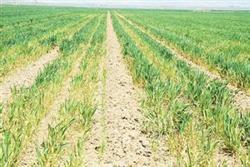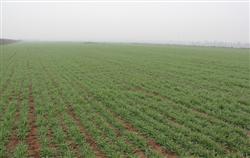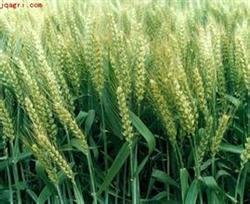Experience of High-yield cultivation of Spring Wheat in dry farming

First, the selection of improved varieties and reasonable yield components are the premise of high yield of wheat to select drought-resistant spring wheat varieties to achieve the purpose of water saving. Ningchun 16 and Xinchun 9 with high yield, drought resistance, fertilizer resistance and lodging resistance were mainly selected in our regiment. The quality of seeds should reach the standard of second-class improved varieties. For every 667m2 basic seedlings, more than 400000 ears were harvested, the average number of grains per ear was 260.28 grains, the 1000-grain weight was more than 48g, the weight per panicle was more than 1.3g, the yield was converted to 85 per cent, and the per unit yield was more than 400kg. Second, soil nutrients are an important basis for high wheat yield. Soil nutrients in the plough layer should generally reach 1.0% of organic matter, more than 50 mg / kg of alkali-hydrolyzable nitrogen, more than 20 mg / kg of available phosphorus, and more than 0.08% of total nitrogen. Third, water is the source of high yield of wheat. during the crop growth period (from early May to early August), the rainfall is more than 300mm, and the plots that are conditionally watered must be irrigated once or twice. In years of drought, all kinds of drought-resistant sprinkler irrigation equipment should be used to fight drought and ensure a bumper harvest. Fourth, the implementation of key cultivation measures is the guarantee of high yield of wheat. Make full preparations before sowing ① the land is ready to loosen and improve the soil and store water with the soil. Select the land with middle and upper soil fertility, rape and other crops in the previous stubble and the straw has been returned to the field, turn over in late autumn and fertilize the whole layer. The amount of fertilizer applied is more than 50% of the total nitrogen fertilizer and 70% to 90% of the total phosphate fertilizer. The ploughing depth is more than 28 cm, and the mechanical force is flat to the state of waiting for sowing. Spring rake to achieve "Qi, flat, loose, broken, moisture, net" six-character standard. All the farmland is operated by high-power tractors, which is an important farming method for our regiment to gain high yield. ② seed treatment seeds were cleaned by grain cleaner, then selected by sorting machine (nest selection, gravity selection), and coated after seed selection. The input of ③ fertilizer increases the application of fertilizer and replenishes water with fertilizer. 22,25kg of nitrogen fertilizer and 21kg of phosphate fertilizer were applied every 667 square meters. 1 / 3 of this amount of fertilizer was used as seed fertilizer, and 2 / 3 was used as base fertilizer and late topdressing. The ratio of nitrogen to phosphorus is 1 ∶ 0.75.The whole layer fertilizer is 25kg per 667m2, the middle layer fertilizer is 10kg / m ~ 15kg, and the potash fertilizer is 3kg / m ~ 5kg. Soil testing and formula fertilization is carried out where possible, and precision fertilization technology is fully implemented. Make full use of the advantages of animal husbandry in our regiment, combined with the results of soil testing, vigorously accumulate and transport organic fertilizer, transform medium-and low-yield fields, applying 1000 kg of sheep dung or 100kg of oil residue every 667m2, combined with nitrogen, phosphorus and potassium. In order to improve the processing quality, micro-fertilizers such as S, B, Zn, Cu, Mn and Mo should be added appropriately. Organic fertilizer or full-layer fertilization was applied before autumn turning, while the rest of chemical fertilizer and micro-fertilizer were used for middle-layer fertilization and foliar fertilization. two。 Pay close attention to sowing and cultivate strong seedlings and use water economically. When the previous work is ready, it is necessary to achieve timely dry sowing. When the topsoil is thawed for 5 cm, the seeds can be sown at the top, and the sowing will end before April 20. The sowing rate is 28,30kg per 667 square meters, and the seeds are sown with equal row spacing with a 24-row planter. When sowing, the rows should be straight and uniform (15 cm equal spacing, the error between rows is less than plus or minus 2 cm), the sowing depth is the same (the depth is 3.5 cm to 4.5 cm), the weight is not leaking (the width of the row is 13 cm to 17 cm), the seed is uniform (100 seeds per meter per row), the soil cover is tight, the suppression is true, and there are no floating seeds on the surface. 3. Strengthen field management efforts ① check seedling replanting after missing sowing, check seedling replanting in time to ensure the number of seedlings in 667 square meters. ② topdressing looks at seedling topdressing, point and slice combination. Strong seedlings 667 square meters spread or strip application of urea 5kg, weak seedlings 667 square meters spread or strip application of urea 810kg. ③ reasonable irrigation conditions of land, irrigation should look at the sky, look at the ground, look at crops, three-leaf period watering, two water according to soil moisture and growth to determine. ④ chemical weeding in wild oat 2-4 leaf stage with 667 square meters of 70 milliliters, 20 kg of water control; 667 square meters of dicotyledonous weeds with 1.5g giant star, 20 kg of water control, the weed control effect reached more than 90%. ⑤ was used to prevent lodging spring wheat at jointing stage with 200ml chemical control, and the plots with excessive population density were sprayed with 150ml in the second stage 7 days after the first spraying. ⑥ foliar fertilization combined with seedling chemical removal, 667m2 spraying 200g of potassium dihydrogen phosphate and 500g of urea, no less than 15kg of water, foliar fertilization should be light rather than concentrated. 4. Do a good job in pest control and prevention. ① do a good job in pest control and observe the occurrence period of diseases and insect pests, mainly nematode disease, total erosion disease, scab, rust, armyworm and meadow borer. Timely use of carbendazim, trimethoprim, saidan and Jiuxiaoling for mechanical control. ② aircraft chemical prevention in the early booting stage, the aircraft was sprayed with 25% trimethoprim 50g / 667m 2, 70% methyl thiophanate wettable powder 70g / 667m 2 to prevent spring wheat rust and scab. At the same time, foliar micro-fertilizer can be combined with aircraft operation to lay the foundation for high yield of wheat. 5. In the middle and later stage, the management ① was used to organize manpower to carry out manual impurity removal in the improved seed field in order to ensure the purity of the seeds. ② yield measurement and harvest prepare well before harvest and forecast yield in advance. During mechanical harvesting, when the wheat is generally yellowed, the grain enters the late ripening stage, and the water content is less than 15%, it should be harvested according to the quality requirements (the loss during harvest shall not exceed 3%, the crushing rate shall not exceed 1%, and the cleaning rate shall be more than 95%). The seed field is harvested first, and the straw is returned to the field in time, and the soil is turned over and prepared in autumn.
- Prev

The spring tube of wheat focuses on fertilizer and water.
It is common to crack down on hoes and rakes at the top. Rake or suppression can crush soil blocks, settle soil, increase soil moisture and preserve soil moisture, transfer deep water, and promote roots and tillers. Through suppression, capillaries in the soil are formed, and the deep soil moisture rises to the upper soil along the capillaries, which is beneficial to nourish the root growth. Hoe and rake in early spring.
- Next

It is the key to lay a good foundation for high yield of winter and spring wheat.
Henan Province is a major province of wheat production. in recent years, the state and province have issued a series of policies to benefit farmers to support the development of wheat production, so that the agricultural production conditions of our province have been greatly improved and the production level has been continuously improved. the total yield and per unit yield of wheat have reached an all-time high for five consecutive years. In 2007, the sown area of wheat reached 75.66 million mu.
Related
- The first cup of black tea in spring, the flavor and history of tea gardens in Kenya, Africa
- The computer can not only choose potatoes, but also grow tea rice. AI will grow winter oolong tea champion.
- It is not only the inflated tea bitten by insects, but also engraved with the four seasons tea in Beipu.
- The Oriental Beauty Tea Festival in Zhuxian County takes the stage at the weekend to experience the plus-size feast of oil tea.
- & quot; Oriental Beauty Tea & Exploration of Emei in Hsinchu, the hometown of quot;
- The new variety of strawberry "Tainong 1" dessert is the first choice with mellow aroma. Crimson gorgeous
- History of Tea in Taiwan: from Wild Inner Mountain to Export Tea Garden
- Two types of Taiwan Oriental Beauty Black Tea won the British three-Star Award for Childhood Tea Xiang Zhang Jiaqi changed from pilot to champion tea maker.
- Banana species and varieties: the planting history of Taiwan Xianren banana and dwarf banana is long, is banana disease resistant?
- Coffee planting Technology: Qianjie Coffee from Seedling to harvesting

